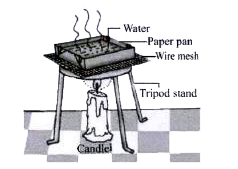Abhinav is a student of class IX. One day all the students were performing experiments in the science laboratory. Just then, the chemistry teacher, Mrs. Prasad, came to the laboratory. She had three beaker in her hands labelled A, B and C. All the beakers contained colourless liquids which looked exactly the same. Mrs. Prasad turned to the students and said that one of the beakers contained a pure substance whereas the other two beakers contained solutions of the same solute in the same solvent but different concentrations. She also told the students that the weight one of the three beakers A, B and C were 110g, 120g and 100g respectively. Mrs. Prasad wanted one of the students to find out experiementally which beaker contained a pure substance and which two beakers contained solutions. She also wanted them to show experimentally two properties which could tell why the solutions are considered mixtures, even though they are homogeneous substances. Mrs. Prasad wanted one of the the students to find out experimentally which beaker contained a pure substance and which two beakers contained solutions. She also wanted them to show experimentally two properties which could tell why the solutions are considered mixtures, even though they are homogeneous substances. Mrs. Prasad allowed them to use any required apparatus from the laboratory for the purpose. Abhinav offered to perform the experiements to distinguish between the pure substance and solutions and also to show experimentally why solutions are considered mixtures.
(a) What did Abhinav do to find out which of the given liquids is a pure substances and which liquids are solutions ? What were the observations made by Abhinav ?
(b) Whay did Abhinav conclude form the above observations ?
(c) Which property of the pure substance is exhibited by this experiment ?
(d) Which properties of a solution are exhibited in this experiement ?
(e) What values are displayed by Abhinav in this episode ?
(a) Abhinav took the three liquids A,B,C and D in three different china dishes and evaporated them by heating. Abhinav observed that :
(i) The liquid in beaker A evaporated evaporated leaving behind a white 'solid' residue.
(ii) The liquid in beaker B evaporated leaving behind much more quantity of white solid residue.
(iii) The liquid in beaker C evaporated completely, without leaving behind behind any residue
(b) Abhinav concluded that :
(i) Liquids A and B are solutions or mixtures (becuase they leave behind residue on evaporation)
(ii) Liquid C is a pure substance (because it evaporates completely, without leaving behind any residue)
(c) The property of a pure substance exhibited by this experiement is that is pure substance cannot be separated
(c) The property of a pure substance exhibited by this experiement is that a pure substance cannot be separated into its constituents by physical methods (here evaporation)
(d) The properties of a solution exhibited in this experiment are that :
(i) a solution can be separated into its components by physical methods (here evaporation)
(ii) a solution has a variable composition (here the two solutions contain different amounts of dissolved solids)
(e) The values displayed by Abhinav in this episode are (i) Knowledge, of pure substances and solution
(ii) Application of knowledge in solving problems, and
(iii) Boldness (to accept challenge)
Topper's Solved these Questions
Similar Questions
Knowledge Check
An open beaker containing a pure solvent and a seconf beaker containing a solution in the same solvent with a non-volatile solute are sealed in a container. Over the period of time
Athe volume of solution increases and the volume of solvent decreasesBthe volume of both solution and solvent increasesCthe volume of solution decreases while volume of solvent increasesDthe volume of both solution and solvent decreasesMr. Goyal, a science teacher showed the following experimental set up to the students. Which of the following is the correct observation and its explanation?
 AThe paper pan catches fire and the water spills all over the wire mesh because paper is inflammable.BThe paper pan has a very high ignition temperature so it does not catch fire.CThe water in the pan absorbs heat from the candle flame and thus prevents the paper to reach the ignition temperature.DThe paper pan helps the water vapours to condense back to water.
AThe paper pan catches fire and the water spills all over the wire mesh because paper is inflammable.BThe paper pan has a very high ignition temperature so it does not catch fire.CThe water in the pan absorbs heat from the candle flame and thus prevents the paper to reach the ignition temperature.DThe paper pan helps the water vapours to condense back to water.
Two beaker contain hot water of the same temperature one beaker is placed in anotehr beaker containing cold water and the other breaker in fornt of a rotating fan .It is observed that the beaker placed infront fan cools faster .explain the reason
View SolutionMr. Prasad saw me at a ....... shop. (barber's, barber)
View SolutionTwo beaker contain hot water of the same temperature one beaker is placed in anotehr beaker containing cold water and the other breaker in fornt of a rotating fan .It is observed that the beaker placed infront fan cools faster .explain the reason
View SolutionMr. Prasad wants nothing but buy a flat.
View SolutionA student prepared solutions of (i) an acid and (ii) a base in two separate beakers. She forgot to label the solutions and litmus paper is not available in the laboratory. Since both the solutions are colourless how will she distinguish between the two ?
View SolutionA student prepared solutions of (i) an acid and (ii) a base in two separate beakers. She forgot to label the solutions and litmus paper is not available in the laboratory. Since both the solutions are colourless how will she distinguish between the two ?
View Solution
